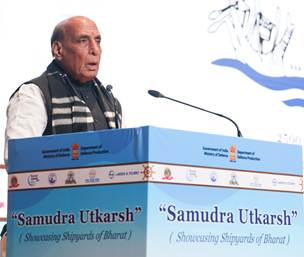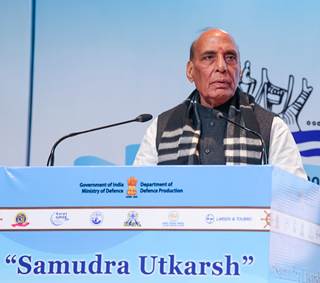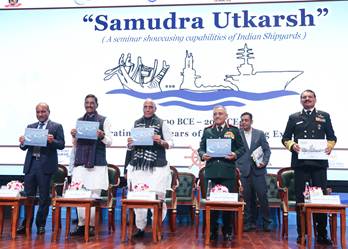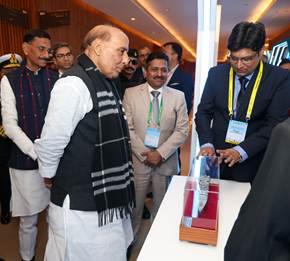Ministry of Defence
Global players must tap the potential of India’s vibrant shipbuilding industry to co-develop next-gen maritime capabilities & create a secure future: Raksha Mantri at Samudra Utkarsh
“Our shipyards are capable of delivering aircraft carriers to research vessels & commercial ships, the capability positions India to become a global hub for shipbuilding, ship repair & maritime innovation”
“Indian shipyards are vital pillars of our emerging Blue Economy”
Posted On:
25 NOV 2025 2:57PM by PIB Delhi
Raksha Mantri Shri Rajnath Singh has urged international partners to tap the potential of India’s vibrant shipbuilding industry and co-develop next-generation maritime capabilities, thereby creating sustainable technologies and resilient supply chains while shaping an innovative, inclusive & secure future for the world. He was delivering a keynote address at Samudra Utkarsh, a seminar organised by the Department of Defence Production, showcasing the capabilities of Indian shipyards, in New Delhi on November 25, 2025.

Raksha Mantri asserted that the Indian shipbuilding industry, composed of the spirited Public Sector Undertakings and dynamic private sector partners, safeguards national interests regionally & globally, and India stands ready to help shape the maritime century by ‘building not only ships, but trust’; ‘not only platforms, but partnerships’. “What truly sets India apart is its integrated end-to-end shipbuilding ecosystem. From concept design and modular construction to outfitting, refit, repairs, and full life cycle support, every stage of the shipbuilding process is indigenously developed and executed. Our public and private shipyards, backed by thousands of MSMEs, have created a robust value chain that spans steel, propulsion, electronics, sensors, and advanced combat systems,” he told the industry stakeholders, foreign partners, delegates and officers from the Armed Forces & Ministries present on the occasion.
Shri Rajnath Singh highlighted that India’s shipbuilding ecosystem stands on the strength of multiple world-class platforms that reflect technological maturity and industrial depth. He pointed out that flagship projects, such as India’s first indigenous aircraft carrier INS Vikrant, Kalvari-class submarines and stealth frigates & destroyers, underline not only the naval strength of the country, but also the expanding design capability, automation, and systems integration expertise.

Raksha Mantri added that Indian shipyards are emerging as major players in the global commercial and dual-use maritime industry, mentioning about the high-end passenger and cargo vessels, coastal ferries, pollution-control & research ships, and the world’s most advanced deep-sea mining support vessel for ISRO and National Institute of Ocean Technology. He commended the private sector for rising as a force multiplier by producing green-fuel vessels, LNG carriers, Roll-On Roll-Off vessels, and high-efficiency commercial ships for domestic use and global clients.
“We are capable of delivering aircraft carriers to advanced research vessels and energy-efficient commercial ships. This integrated capability positions India strongly to become a global hub for shipbuilding, ship repair, and maritime innovation in the coming decade,” said Shri Rajnath Singh.
Raksha Mantri underlined the fact that every ship of the Indian Navy and the Indian Coast Guard currently under construction is being built in Indian shipyards, which stands as a testament to Aatmanirbhar Bharat as envisioned by Prime Minister Shri Narendra Modi. He emphasised that the transformation of India’s shipbuilding sector is underpinned by a series of forward-looking policy reforms including the Maritime India Vision 2030 and Maritime Amrit Kaal Vision 2047, Defence Production & Export Promotion Policy and Defence Procurement Manual 2025.
Shri Rajnath Singh stated that the result of the Government’s efforts is that the Indian Navy has 262 ongoing indigenous design and development projects in advanced stages. “We also boast of high indigenous content of our platforms. Some of our shipyards are on track to secure 100% indigenous content within this decade. This means that any naval vessel supplied from India will suffer minimum supply chains disruptions,” he added.

Raksha Mantri exuded confidence that soon India’s commercial fleet too will be built entirely within the country. “Our shipyards on both coasts now operate modern fabrication lines, advanced material-handling systems, automated design tools, model testing facilities, and digital shipyard technologies. These are all aligned with the global benchmarks,” he said.
Describing Indian shipyards as vital pillars of India’s emerging Blue Economy, Shri Rajnath Singh said that beyond defence platforms, a wide range of specialised vessels are designed & built for deeper scientific understanding of seas, strengthen monitoring of marine ecosystems, ensure sustainable exploitation of fisheries and enhance maritime law-enforcement capabilities across India’s vast coastline and Exclusive Economic Zone. Highlighting the shift towards green, efficient, and sustainable shipbuilding practices, he said the Indian shipyards are increasingly adopting environment friendly technologies, which have positioned them as active contributors to climate-resilient maritime growth.
Raksha Mantri made special mention of the Humanitarian Assistance & Disaster Relief missions carried out by Indian platforms, including Operation Samudra Setu during COVID-19, Operation Brahma during Myanmar earthquake of 2025, and the daring medical evacuation from MV Heilan Star by INS Vikrant this year. These missions, he said, underscore that Indian shipyards build ships which protect borders, save lives, and uphold global maritime stability. These activities are further facilitated by digital transformation, AI-enabled shipyard processes, hybrid propulsion, and future-fuel readiness, aligning India with global benchmarks, he added.

On the increasing number of foreign ships visiting Indian shipyards for complex refits, Shri Rajnath Singh termed it as a clear recognition of India’s capability, reliability, and cost competitiveness. “We want to become the preferred sustainment and repair hub for the entire Indo-Pacific region,” he said.
On the theme of the seminar ‘2500 BCE - 2025 CE… Celebrating 4,524 Years of Shipbuilding Excellence’, Raksha Mantri stated that the theme reflects not just an industrial ambition, but a civilisational continuum. He pointed out that, from Lothal’s ancient docks to the modern shipyards of Mumbai, Goa, Visakhapatnam, Kolkata and Kochi, India’s maritime journey is a story of evolution & resilience. The centuries-old spirit of exploration, innovation and connectivity is being carried forward today as well, he added.
In his address, Raksha Rajya Mantri Shri Sanjay Seth dubbed Samudra Utkarsh as a momentous event that celebrates and showcases India’s shipbuilding capability. “Samudra Utkarsh reminds us of India’s rich heritage and demonstrates its ability and capacity paced with modern cutting edge technologies and stronger national capability in shipbuilding and repair. Under the leadership of PM Modi and guidance of Raksha Mantri, our shipbuilding sector has grown multi-fold. Their vision has provided impetus towards strengthening our maritime sector,” he said.
Shri Sanjay Seth added that Samudra Utkarsh highlights the latest innovations, that provide thrust to the rising confidence of India’s maritime industry. He called for continued focus in the field of innovation, skill development, collaboration, and export competitiveness, terming them as essential ingredients for India to grow as a major shipbuilding nation. He also shed light on India’s long maritime history, stating that right from the Indus Valley civilisation, the thriving shipyards have always connected the country to the world through seas.
Speaking on the occasion, Secretary (Defence Production) Shri Sanjeev Kumar termed the shipyards as pillars of India's industrial strength and self-reliance, which he said, over the past decade, have transformed to modern, globally competitive yards, adopting digital tools, automation & professional best practices. He emphasised that whether it is complex warships, mid-life upgrades, or commercial repairs, India today offers an ideal combination of capability, location, and quality.
“Our shipyards are not just industrial facilities; they are symbols of India's maritime resurgence and growing national confidence. The Government remains fully committed to strengthening this sector, supporting modernisation, capacity creation, skilling, industry partnerships, and green shipbuilding for the future. Guided by the vision of the Prime Minister under SAGAR (Security and Growth for All in the Region) and supported by our long-term maritime road maps the Maritime India vision 2030 and maritime Amrit Kaal vision 2047, our shipyards are shaping a self-reliant, innovative, and globally connected maritime India,” said the Secretary (Defence Production).
As part of the event, Raksha Mantri released a coffee-table book ‘Shipyards of Bharat - Infrastructure, Capability, Capability, Outreach’ and two compendiums - ‘Samudra Navpravartan’ and 10-year AI roadmap for Indian shipyards.


Raksha Mantri and Raksha Rajya Mantri also visited the stalls set up by various shipyards, showcasing the modern infrastructure and the expansion plans. Sessions on warship building, submarine construction/refit, unmanned/autonomous systems, and commercial shipbuilding & repair were also organised during the event. Chief of Defence Staff General Anil Chauhan, Chief of the Naval Staff Admiral Dinesh K Tripathi and other senior civil & military officials were present on the occasion.


****
VK/SR/Savvy/PS
(Release ID: 2194058)
Visitor Counter : 751